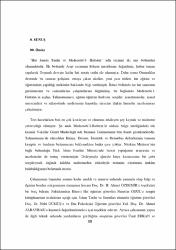| dc.description.abstract | Türk İslam sanatları içerisinde hat sanatı, yabancı sanat akımlarının etkisinden uzak varlığını daima korumuş ve her dönem devlet yönetimi tarafından da destek bulmuştur.Hat sanatı eğitim ve öğretimi sıkı bir disiplin içerisinde geleneksel metotla usta ? çırak ilişkisi çerçevesinde kişiye özel ders yöntemiyle yapılmaktaydı. Yazı eğitim ve öğretimi tarihi süreç içerisinde özellikle Osmanlılar döneminde gerek saray içi resmi eğitim kurumlarında ( Enderun, Divan-ı Hümayun? ) gerekse saray dışı eğitim kurumlarında (Sıbyan Mektebi, Medreseler?) büyük ilgi görmüş ve ders programlarında yerini almıştır. Bunların haricinde söz konusu sanat, hat sanatkârları tarafından kendi özel mekânlarında öğretilmiştir. Hat eğitim ve öğretimi XX. yüzyılın başlarına kadar bu şekilde devam etmiştir. II. Meşrutiyet sonrası eğitim öğretim alanında yapılan çalışmalar sonucunda hat sanatı başta olmak üzere diğer geleneksel sanatların eğitimine de yer vermek üzere Medresetü'l- Hattatin açılmıştır (31 Mayıs 1914). Bu medresede de hat eğitimi yine geleneksel usulle verilmiştir. 1924'te medreselerin kapatılması esnasında ve 1928'de gerçekleştirilen Harf İnkılâbı münasebetiyle kısa süreliğine de olsa kapatılan medrese, farklı isimlerle faaliyetlerine devam etmiştir. 1936'da ise Güzel Sanatlar Akademisi bünyesine dâhil edilmiştir. In Turkish ? Islamic Arts, calligraphy art has always saved itself from movements of foreign art and it has been always supported by administration of government at the point of schooling.Calligraphy art used to be done in strict discipline by traditional method, in relationship of craftsman-apprentice by method of private education. In historical periods, it had not only been taken attention by indoor of palace?s formal constitution of education, it had also taken its place in curriculum. In front of these, the art had been taught by calligraphy artists in their special places. Its schooling had continued in the same situation till the beginning of the 20th century. After the constitutional monarchy, in conclusion of works in schooling parts, Medresetü?l hattatın had been opened (31 March 1914) on condition of ginning part, firstly calligraphy art, schooling of other traditional arts. In this medrese, calligraphy art had been given in method of traditional. In 1924 in duration of closure of medreses and because of revolution of Alphabet, medrese, closed at short time, had continued its activities in different names. In 1936, it had been included in academy of fine arts. | en_US |


















